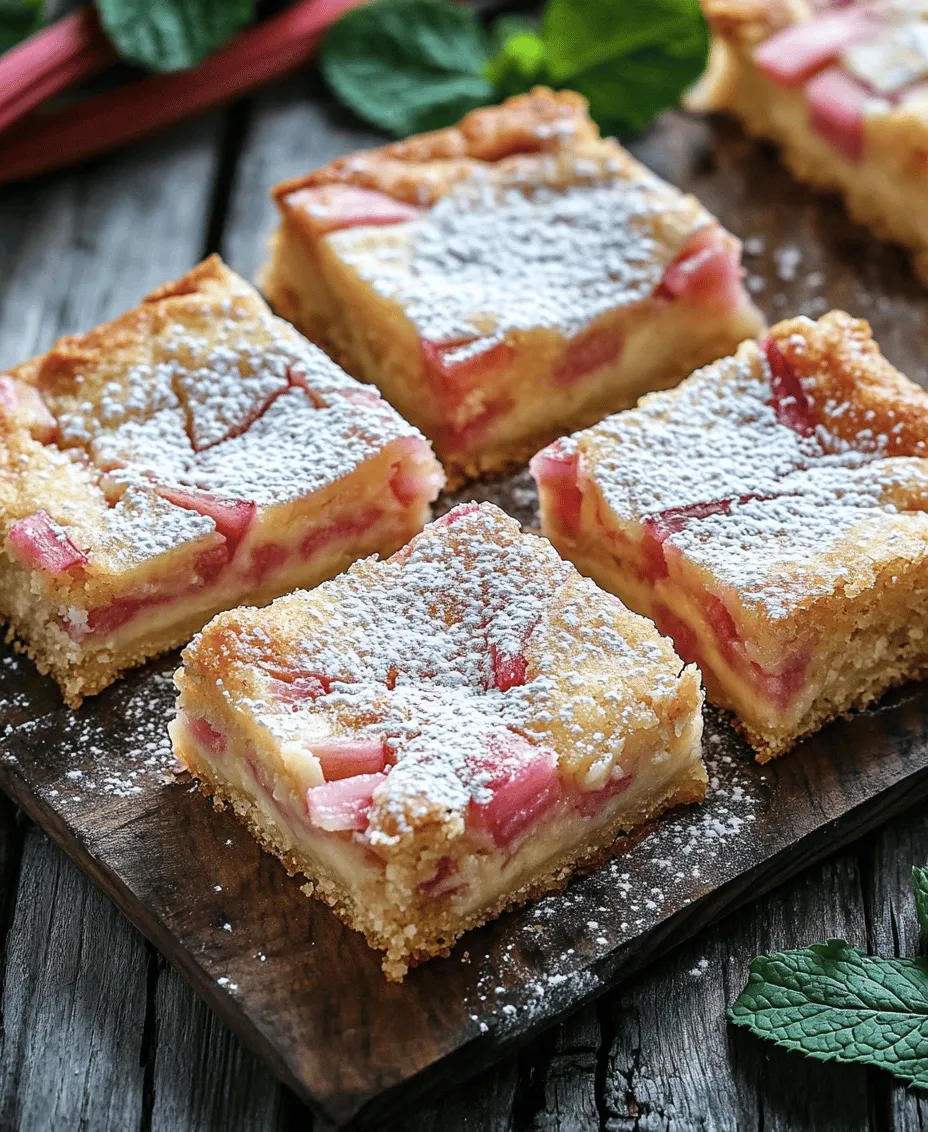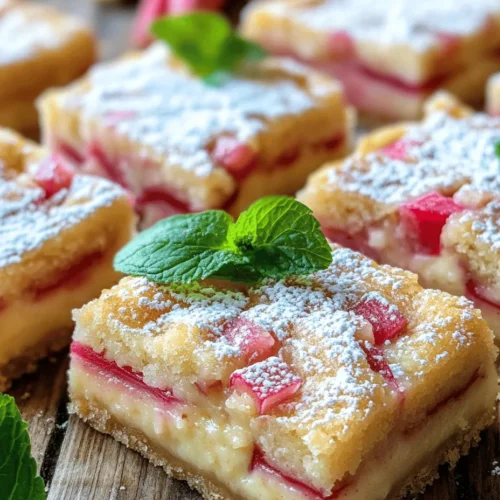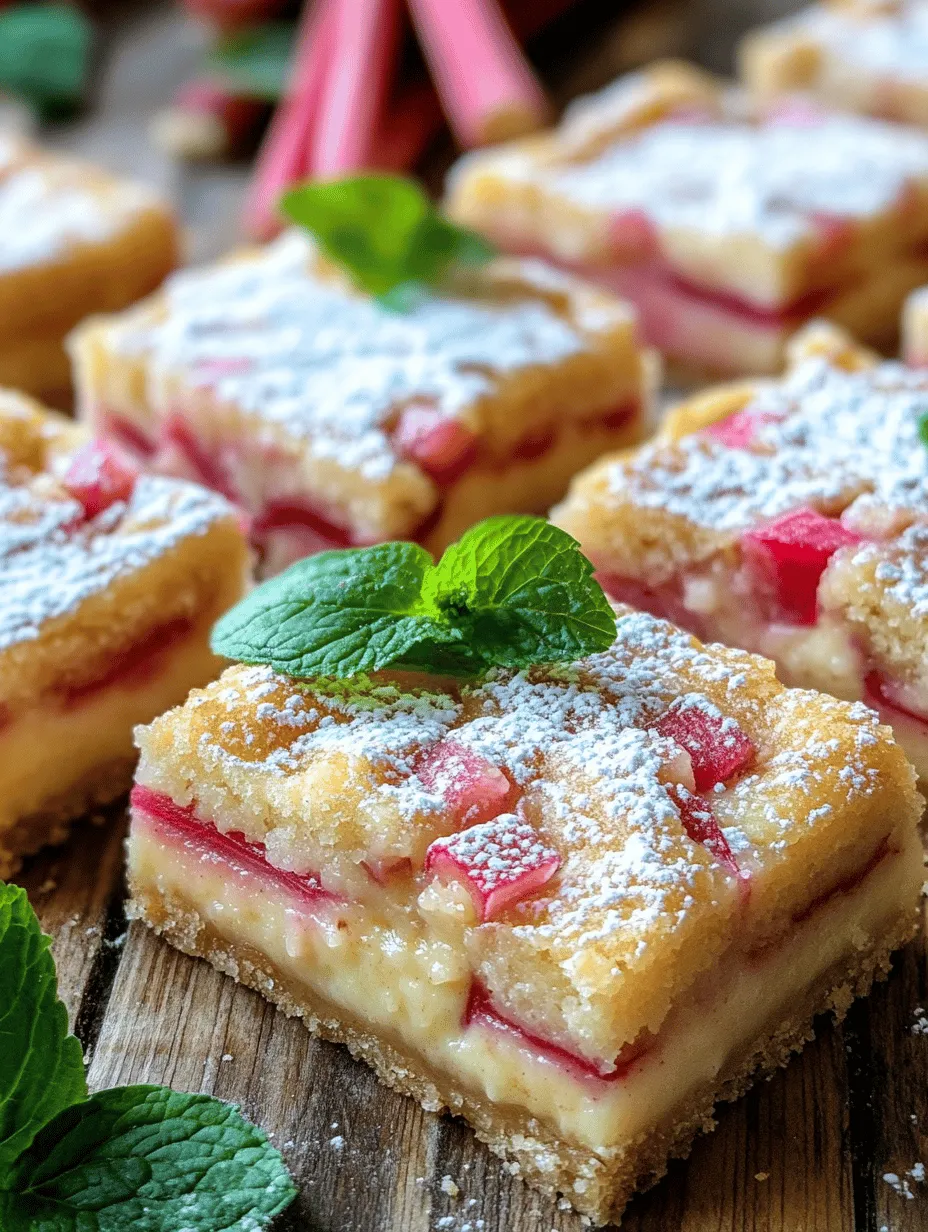Introduction
Rhubarb, with its vibrant red stalks and unique tart flavor, is one of those ingredients that can elevate a dish from ordinary to extraordinary. Often considered a vegetable but used as a fruit in culinary contexts, rhubarb’s versatility shines in desserts, particularly in sweet and tangy rhubarb custard bars. This delightful treat perfectly balances the natural tartness of rhubarb with a rich, creamy custard, making it an irresistible option for spring and summer gatherings. Whether you are hosting a brunch, celebrating a special occasion, or simply indulging in a sweet treat, these rhubarb custard bars are sure to impress.
As you embark on this culinary adventure, you’ll find that the recipe is not only straightforward but also rewarding. Readers can expect a step-by-step guide that results in a luscious dessert with a buttery crust, a smooth custard filling, and the delightful zing of fresh rhubarb. The combination of textures and flavors creates a dessert that is both sophisticated and comforting, appealing to a wide range of taste preferences. Let’s dive deeper into the world of rhubarb and explore the essentials needed to create these sweet and tangy bars.
Understanding Rhubarb
Rhubarb has a rich history that dates back to ancient times, originally cultivated for medicinal purposes in Asia before making its way to Europe and eventually America. By the 18th century, rhubarb found its way into culinary applications, particularly in desserts, where its tartness complements sweeter ingredients beautifully. Today, rhubarb is a beloved seasonal ingredient, especially in spring when it is harvested at its peak freshness.
Beyond its historical significance, rhubarb is celebrated for its impressive nutritional profile. It is low in calories and a good source of vitamins K and C, as well as dietary fiber. Rhubarb also contains antioxidants that contribute to overall health and wellness, making it a guilt-free addition to your dessert repertoire. The high acidity of rhubarb not only contributes to its unique flavor but also helps to balance out the sweetness from other ingredients, creating a harmonious blend that tantalizes the taste buds.
With its distinctive flavor and health benefits, rhubarb lends itself perfectly to sweet desserts. When combined with sugars, eggs, and creamy components, it transforms into a delectable filling that can be used in pies, crumbles, and, of course, custard bars. The contrast between the tangy rhubarb and the sweet, rich custard creates a dessert that is both refreshing and satisfying.
Ingredients Breakdown
Overview of the Crust Ingredients
The foundation of any good dessert is its crust, and the crust for rhubarb custard bars is no exception. Here’s a breakdown of the essential ingredients you’ll need:
– All-Purpose Flour: This forms the bulk of the crust, providing structure and stability. A blend of all-purpose flour ensures a tender yet sturdy base that holds up against the moist filling.
– Powdered Sugar: Using powdered sugar instead of granulated sugar gives the crust a delicate sweetness and a finer texture, resulting in a melt-in-your-mouth experience.
– Butter: Unsalted butter lends richness and flavor to the crust. It should be cold and cubed for the best texture, creating a flaky, tender crust when baked.
– Egg Yolk: The addition of an egg yolk enriches the crust, adding moisture and helping to bind the ingredients together.
– Vanilla Extract: A splash of vanilla enhances the flavor profile of the crust, imparting a subtle sweetness.
– Salt: A pinch of salt is crucial in balancing the flavors, enhancing the sweetness and helping to bring out the overall taste of the crust.
Importance of Each Ingredient
When selecting ingredients for the crust, quality matters. Opt for high-quality unsalted butter for the best flavor, and consider using organic flour and sugar for a cleaner taste. The egg yolk should be fresh, as it plays a significant role in texture and flavor. Pay attention to the vanilla extract you choose; pure vanilla extract will yield a more robust flavor than imitation vanilla.
Overview of the Filling Ingredients
The filling for rhubarb custard bars is where the magic truly happens. Here’s what you’ll need:
– Fresh Rhubarb: The star of the show, fresh rhubarb is essential for achieving the proper flavor and texture. When selecting rhubarb, look for firm, bright stalks that are crisp and free from blemishes.
– Granulated Sugar: This sweetens the filling and balances the tartness of the rhubarb. Adjust the amount based on your personal taste and the natural sweetness of the rhubarb.
– Eggs: Eggs provide structure and richness to the custard filling, creating a smooth and creamy texture when baked.
– Vanilla Extract: Just like in the crust, vanilla extract enhances the overall flavor, adding depth to the custard.
– Heavy Cream: This ingredient is what makes the custard rich and velvety. The cream also helps to balance the tanginess of the rhubarb.
– All-Purpose Flour: A small amount of flour helps thicken the custard, ensuring it sets nicely without being too runny.
– Baking Powder: A hint of baking powder adds a touch of lift to the custard, contributing to a lighter texture.
– Salt: Again, a pinch of salt is essential to balance the flavors and enhance the sweetness.
Discussion on Fresh Rhubarb and Preparation
When working with rhubarb, freshness is key. Always choose rhubarb that is in season, typically from late spring to early summer. Fresh rhubarb should be bright in color, firm, and crisp. Avoid stalks that are wilted or have developed any signs of decay.
Before using rhubarb, it’s important to prepare it properly. Start by washing the stalks thoroughly to remove any dirt or debris. Then, trim away the tough ends and slice the rhubarb into uniform pieces, typically about ½ inch thick. This ensures even cooking and allows the rhubarb to break down properly during baking, releasing its natural flavors and juices.
Garnish Options
To elevate your sweet and tangy rhubarb custard bars, consider adding garnishes that enhance both visual appeal and flavor. A sprinkle of powdered sugar on top just before serving can add a touch of elegance, while fresh mint leaves can introduce a refreshing contrast. Additionally, a dollop of whipped cream or a scoop of vanilla ice cream served alongside the bars provides a creamy complement to the tart filling.
Step-by-Step Instructions
Preheating the Oven and Preparing the Baking Dish
Before diving into the preparation of your rhubarb custard bars, it’s vital to preheat your oven to 350°F (175°C). Preheating ensures that the bars bake evenly and achieve the desired texture. While the oven is heating, prepare your baking dish—typically an 8×8-inch square pan works perfectly for this recipe. Grease the pan lightly with butter or line it with parchment paper for easy removal after baking.
Preparing the Crust
1. Combine Dry Ingredients: In a medium mixing bowl, whisk together the all-purpose flour, powdered sugar, and salt until well combined. This step ensures that the ingredients are evenly distributed, which is essential for a consistent crust.
2. Cut in the Butter: Next, add the cold, cubed butter to the flour mixture. Using a pastry cutter or your fingers, work the butter into the dry ingredients until the mixture resembles coarse crumbs. Be careful not to overwork the dough; you want to retain some small pieces of butter for added flakiness.
3. Incorporate Egg Yolk and Vanilla: Add the egg yolk and vanilla extract to the mixture. Mix gently until the dough comes together. If the dough is too crumbly, you can add a teaspoon of cold water to help it bind.
4. Press into Baking Dish: Transfer the dough to the prepared baking dish. Using your fingers, press the dough evenly into the bottom of the pan, ensuring that it covers the entire surface and reaches up the sides slightly. Prick the bottom of the crust with a fork to prevent it from puffing up during baking.
5. Bake the Crust: Place the crust in the preheated oven and bake for about 15 minutes, or until it is lightly golden. Keep an eye on it to prevent over-baking, as a golden crust will provide a lovely contrast to the creamy filling.
With these steps complete, you are well on your way to creating a delightful batch of sweet and tangy rhubarb custard bars. The combination of the buttery crust and the vibrant, tart rhubarb filling will surely make this dessert a standout at any gathering. Stay tuned for the next part of this article, where we’ll delve into the assembly and baking of these delicious bars!

Mixing Techniques for Achieving the Right Texture
When making Sweet and Tangy Rhubarb Custard Bars, achieving the right texture is crucial for a successful dessert. The crust should be firm yet tender, while the custard filling needs to be smooth and creamy. Begin by ensuring that your butter is at room temperature; this allows it to cream well with the sugars, resulting in a light and airy texture.
For the crust, use a pastry cutter or your fingertips to work the flour, sugar, and butter together until the mixture resembles coarse crumbs. You want to avoid overmixing; otherwise, the crust may become tough. When you add the egg, mix just until combined. Overmixing at this stage can lead to a dense crust. After pressing the mixture into your baking dish, use a fork to poke a few holes in the bottom. This will prevent the crust from puffing up during baking, ensuring a flat base for your custard filling.
Visual Cues for When the Crust is Ready
Baking the crust is a critical step in making these bars. You’ll know the crust is ready when it turns a light golden brown and feels firm to the touch. Typically, it should bake for about 15-20 minutes at 350°F (175°C). Keep an eye on it during the last few minutes of baking; you want to catch it just at the right moment to avoid over-baking, which can lead to a dry crust.
Preparing the Filling
While your crust is baking, it’s time to prepare the custard filling. Start by chopping your rhubarb into small, uniform pieces. This ensures that they cook evenly and integrate well into the custard.
Before mixing the filling, allow the chopped rhubarb to sit for about 15-20 minutes with a sprinkle of sugar. This process draws out the juices from the rhubarb, enhancing its natural sweetness and flavor. Once the rhubarb has released its juices, you can proceed with the next steps.
Importance of Letting Rhubarb Sit to Release Juices and Enhance Flavor
Allowing the rhubarb to rest with sugar is not just a step; it’s an essential technique that transforms the flavor profile of your dessert. Rhubarb is naturally tart, and letting it sit with sugar helps to mellow that tartness, creating a more balanced filling. Additionally, the juices released from the rhubarb will blend beautifully with the custard, creating a smooth and flavorful filling that is both sweet and tangy.
Detailed Explanation of Mixing Techniques for the Custard
To create the custard, whisk together eggs, sugar, and vanilla in a mixing bowl until the mixture is pale and frothy. This aeration is key to achieving a light custard that will set nicely without being dense. Next, gradually add in the milk or cream, mixing gently until well combined. Avoid whisking too vigorously at this stage, as it can create bubbles that may lead to an undesirable texture after baking.
Finally, fold in the prepared rhubarb, ensuring that it is evenly distributed throughout the custard mixture. This gentle folding technique is crucial; you want to maintain the airiness of the custard while ensuring that every bite contains that delicious rhubarb flavor.
Baking the Custard Bars
Once your custard mixture is ready, carefully pour it over the pre-baked crust, spreading it evenly with a spatula. Return the baking dish to the oven and bake at 350°F (175°C) for approximately 25-30 minutes.
Key Indicators for Doneness (Setting and Color)
To determine if your custard bars are done, look for a few key indicators. The custard should be set around the edges but slightly wobbly in the center. The top should have a delicate golden hue, and a toothpick inserted into the center should come out clean or with a few moist crumbs attached. If the toothpick has wet custard clinging to it, give the bars a few more minutes in the oven.
Cooling and Cutting the Bars
Once baked, remove the custard bars from the oven and allow them to cool in the pan for at least 30 minutes before transferring them to the refrigerator. This cooling period is crucial for the bars to set completely. After chilling for a few hours, or ideally overnight, you can cut them into squares or rectangles.
Importance of Cooling for Texture and Flavor Enhancement
Cooling the bars allows the custard to firm up, making them easier to cut and serve. Additionally, as the bars cool, the flavors meld together, enhancing the overall taste experience. The contrast between the tangy rhubarb and the creamy custard becomes more pronounced, making each bite a delightful experience.
Serving Suggestions
When it comes to serving your Sweet and Tangy Rhubarb Custard Bars, presentation can elevate the dining experience. For a simple yet elegant touch, dust the top of each bar with powdered sugar just before serving. Adding a few fresh mint leaves as a garnish not only enhances the visual appeal but also introduces a refreshing aroma.
Pair these bars with a cup of tea or coffee for a delightful afternoon treat. They also make a wonderful dessert when served alongside a scoop of vanilla ice cream or whipped cream, balancing the tartness of the rhubarb with creamy sweetness.
These custard bars are perfect for a variety of occasions, whether it’s a summer picnic, a family gathering, or a potluck dinner. They are sure to impress guests with their unique flavor combination and beautiful presentation.
Storage Tips
To store leftover rhubarb custard bars, keep them in an airtight container in the refrigerator. They will remain fresh for about 3-4 days. If you want to extend their shelf life, consider freezing them. Cut the bars into individual portions, wrap them tightly in plastic wrap, and then place them in a freezer-safe container. They can be frozen for up to three months.
Best Practices for Freezing and Reheating
When you’re ready to enjoy the frozen bars, remove them from the freezer and let them thaw in the refrigerator overnight. For a warm treat, you can reheat them in the oven at a low temperature (around 300°F or 150°C) for about 10-15 minutes, just until warmed through. This method helps to preserve the custard’s creamy texture while bringing back that freshly baked taste.
Conclusion
In summary, the Sweet and Tangy Rhubarb Custard Bars offer a delightful combination of flavors and textures that are sure to please any palate. With a tender crust, creamy custard, and the perfect balance of sweetness and tartness from the rhubarb, this recipe is a must-try for any dessert lover.
Don’t hesitate to experiment with variations, such as adding different fruits or nuts to the custard, or trying out different types of crusts. Each version will bring a unique twist to this classic dessert. Whether you’re serving them at a special gathering or enjoying a quiet evening at home, these bars are a fantastic way to celebrate the flavors of rhubarb. Enjoy your culinary adventure!


